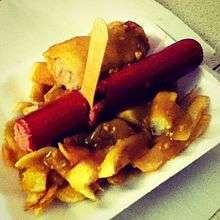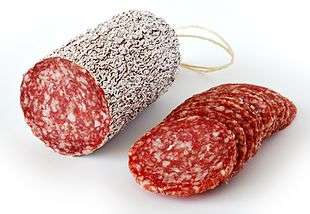Saveloy

A saveloy is a type of highly seasoned sausage, usually bright red, normally boiled and often available in British fish and chip shops, especially in London, Leeds, Newcastle, and the English Midlands and are occasionally also available fried in batter. The word is believed to originate from the Swiss-French cervelas or servelat, ultimately from the Latin cerebrus; originally a pig brain sausage particularly associated with Switzerland.[1]
Although the saveloy was traditionally made from pork brains, the ingredients of a shop-bought sausage are typically pork (58%), water, rusk, pork fat, potato starch, salt, emulsifiers (tetrasodium diphosphate, disodium diphosphate), white pepper, spices, dried sage (sage), preservatives (sodium nitrite, potassium nitrate), and beef collagen casing.[2]
The saveloy is mostly eaten with chips. In The Pickwick Papers (Chapter LV) Solomon Pell, an attorney at the Insolvent Court, is described as "regaling himself, business being rather slack, with a cold collation of an Abernethy biscuit and a saveloy".[3]
The saveloy is available in Australia where it is consumed at fairs, fêtes, agricultural shows and sporting events, served on a slice of bread or in a bread roll and liberally covered in tomato sauce. At the turn of the 20th century, the saveloy was described in an Australian court case as a "highly seasoned dry sausage originally made of brains, but now young pork, salted"[4] but by the mid-century it was commonly defined by its size as a 19 cm sausage, as opposed to a frankfurter at 26 cm.[5] This distinction may be due to the frankfurter's popularisation (as an ingredient of hot dogs).[6] Despite "frankfurter" sausage makers being the target of violence in World War I,[7] the story that saveloys were once frankfurters, renamed due to anti-German sentiment, is purely apocryphal, as far as Australia is concerned.
Saveloys are popular in New Zealand and Australia, where they are larger than the English type. Beef and chicken varieties are also available. Although they are sold at fish-and-chip shops as in England, they are commonly bought at butchers' shops or supermarkets and cooked by boiling at home. Saveloys are known colloquially as "savs". They are often the basis of the New Zealand battered-sausage-on-a-stick "hot dog", equivalent to a US corn dog, often sold at fairgrounds and public events. A cocktail sausage is a smaller version of the saveloy, about a quarter of the size, sometimes called a baby sav, a "little boy" or "cheerio". These are a popular children's party food in New Zealand and Australia, often served hot alongside sweet, spicy tomato sauce.
Saveloys are also popular in the North East of England where they are eaten hot in a sandwich with pease pudding. Children also eat them with the skins removed as a soft snack, and they can be bought from most local butchers.
Variations
A type of hot dog which is almost indistinguishable from the saveloy is popular in the US state of Maine, where it is commonly known as a "red hot" or "red snapper." It is usually grilled or boiled as is common in the UK. In Australia, saveloys are also known as cheerios.[8]
See also
References
- ↑ "Saveloy - Definition and More from the Free Merriam-Webster Dictionary". Merriam-webster.com. 2012-08-31. Retrieved 2013-03-14.
- ↑ "Counter Loose Saveloys By Each - Groceries - Tesco Groceries". Tesco.com. Retrieved 2014-06-18.
- ↑ "The Pickwick Papers". * The Pickwick Papers at Project Gutenberg. Missing or empty
|url=(help) - ↑ "Saveloy Reticence" in The Examiner, Launceston, Tas, 14 March 1913, p. 6
- ↑ "Variety of Sausage for Home Menus" in The Courier Mail, Brisbane, QLD, 12 September 1951, p. 8
- ↑ "Hot Dog is Favourite American Sandwich" in the Centralian Advocate, 26 October 1951, p. 12
- ↑ "Exciting Night in Sydney" in Barrier Miner, Broken Hill, NSW, 28 November 1915, p. 1
- ↑ Leitner, Gerhard (2004). Australian English - The National Language. Walter de Gruyter. p. 257. ISBN 9783110904871.
